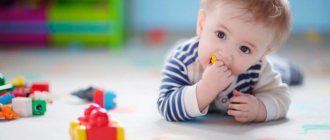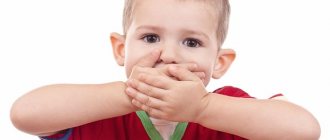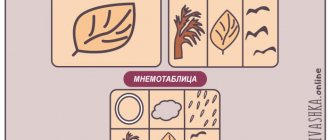“The white-sided magpie was cooking porridge and feeding the children.” Remember the words of the children's nursery rhyme? Can you name the finger that didn't get the porridge? If yes, then you are already familiar with finger massage techniques for children. It is believed that it needs to be done from the first days of life so that the child develops speech correctly. Let's figure out whether this is really so and how to massage children of different ages.
How to develop a child's speech
The movements of the body and organs involved in speech production have common mechanisms, therefore the development of fine motor skills of the hands directly affects the development of speech. It is for this reason that finger exercises for the development of speech in children should take a strong place in your activities with your child.
Training finger movements will, as it were, prepare a platform for further speech development. You can start training your baby’s fingers within the first 5 months. We talk more about fine motor skills here.
Now let's see how you can help your child master their native speech, teach him correct pronunciation, constructing phrases and forming thoughts.
Remember: classes should be held in the most easy, fun and playful way possible. Then they will bring real benefits and bring real pleasure to both of you.
A set of measures for speech development (to be carried out at home):
- Development of fine motor skills
- Speech gymnastics
- Logorhythmics
We do not mention here such areas of work on speech development as speech therapy massage, special exercises for practicing various sounds, developing phonemic hearing, and some others. They are the area of application of exclusively professional knowledge and skills. Here it is better to trust a specialist rather than try to cope with this task yourself. Benefits for developing fine motor skills:
- Matryoshka dolls
- Velvet paper
- Plasticine
- Mosaic
- Laces
- Beans, peas
- Semolina
- Salty dough
- Counting sticks
- Multi-colored clothespins
- Beads
- Cloths with sewn buttons
- Stencils
- Massage ball
- Wooden construction sets
Fine motor skills:
- Passive gymnastics - massage for the development of fine motor skills.
- Active gymnastics - games for the development of fine motor skills: poems and nursery rhymes, finger games, finger theater.
Hand massage
The success of the development of a child’s intelligence and speech lies in massaging the hands. Exposure to them promotes active and coordinated work of both hemispheres of the brain. Speech therapy massage is also important for speech development.
Massage will help strengthen the muscles of the hand. It will speed up the development of your baby’s speech, memory, thought processes, and will also prepare his hands for writing in the future.
To knead and massage your hands, take auxiliary objects. Pencils (they can be rolled between your palms and along the back of your hand), a ball with pimples, a bowl of cereal or beans, and walnuts will be excellent helpers.
Invite your baby to hold them in his hands, roll them along his arms, legs or table surface.
When giving a massage, turn it into a fun game:
"House"
This is our house. (Place your hands together with your fingers.)
And here is its roof. (Interlace the fingers of both hands.)
Where is the pipe in it? She's even taller. (All fingers up)
"Hedgehog"
A prickly hedgehog lives in the forest, (roll the ball on the table) But he doesn’t have legs, he runs on my fingers (roll on my legs and arms) And he puffs very loudly. He runs quickly through the forest and tickles me! I’ll tell him: prickly hedgehog, run to where you live!
Passive gymnastics (massage)
It is better if an experienced professional shows you the massage technique, but you can master the simplest techniques yourself.
The massage is performed with one hand, the other holds the massaged hand. Session duration: 3 – 5 minutes; carried out several times a day.
Massage includes the following types of movements:
- Stroking - performed in different directions;
- Rubbing - differs from stroking with a greater force of pressure (the hand does not slide over the skin, but moves it);
- Vibration - applying frequent blows with the tips of half-bent fingers;
- Massage using a special ball - with the ball you need to make movements in a spiral from the center of the palm to the tips of the fingers; practical advice: you need to use a hard ball, that is, it should not be easily deformed (then the impact will be maximum);
- Flexion-extension of the fingers - the fingers are initially clenched into a fist, each in turn is extended and massaged from the side of the palm in a circular motion from the base to the tip.
We talk more about massage here.
Active gymnastics: games for developing speech using fine motor skills
Game aids:
- Butterflies made of colored paper
- Leaves of colored paper
- Pinwheel
- Cotton balls
- Paper boat
Games for children from 2 months:
- That's how different they are. Objects of various textures and shapes are placed in the child’s hand. The baby must grab the object and hold it for a while. This exercise develops not only motor skills, but also tactile sensations. It’s good if you comment on what is happening: “This ball is smooth,” “This hedgehog is prickly,” etc.
Games for children from 9 months:
- Prefabricated nesting dolls. First you need to collect one doll, then gradually complicate the game; after 2 years it should be a triple matryoshka.
- Pyramids. First you need to use a classic pyramid, the size of the rings of which decreases towards the top.
- Trace along the outline. You need to make cards with images of objects known to the baby, for example, a house, a tree, a car, and paste over their outlines with velvet paper. The essence of the game: an adult guides the baby’s finger along the contour and names the object. Then the outline is covered with beads or peas and the game is repeated.
- Cups and spoons. The child uses a spoon to pour sugar or semolina from one cup to another. You can also transfer beans, peas or nuts by hand.
- Modeling from plasticine. You need to start with a cylinder, and over time complicate the tasks: a ball, a carrot, a snake.
During the games, do not forget to comment on your actions and explain to your child everything that you do.
Games for children from 1 year:
- Strong palms. The child squeezes rubber toys. The best thing is the rubber hedgehog: the needles act like a massager.
- Mosaic. First you need to lay out simple shapes: paths, flowers, squares, and then move on to more complex ones: houses, cars, Christmas trees.
- Constructor. The size of the parts and the complexity of the design depend on the age of the baby: you need to start with the largest parts and the simplest structures, for example, building a turret.
- Beads. The size of the beads also depends on the age of the child. First, instead of beads, you can use balls from pyramids with round parts and string them on a thick cord; then the size of the parts must be gradually reduced, moving on to real beads. For the exercise, medium-sized beads already strung are used. The goal is to teach the child to lay out the outlines of objects from beads. For example, you can lay out a circle, square, heart, spiral, etc.
- Laces. Since lacing has different contents, it makes sense to play with the lacing process - for example, ask the child to sew a dress for his mother (lace-button) or lace shoes (lace-boot).
- Magic tray. Sprinkle a thin layer of semolina onto a tray and run the child’s finger over the cereal. The child is then shown how to draw various shapes. At the age of 2 - 3 years, you can draw numbers and letters.
- Multi-colored clothespins. The essence of the game is to teach the child to independently attach clothespins, and to make the game interesting, you can do this according to a thematic principle: rays to the sun, needles to the hedgehog, rain to the cloud, grass to the ground. Of course, for this you first have to make preparations. This is a rather difficult task for a child. Don't try to achieve results right away. To begin, take the baby’s hands in yours and do the exercise with him.
- Cinderella. You need to mix white and red beans and ask your child to sort them by color.
- Funny pictures. Spread the plasticine evenly over a sheet of cardboard and show your child how to lay out drawings using peas.
- Counting sticks. Show your child how to use counting sticks to lay out different shapes. It is advisable that the counting sticks are not smooth, but ribbed: this serves as an additional massage for the fingers.
- Little sculptor. Dough modeling (dough recipe: 1 cup flour, 1/2 cup salt, a little water). The advantage of dough over plasticine in this case is that the crafts can subsequently be used as toys.
- Fasten the button. You will need two pieces of thick fabric. On one of them, sew three buttons of different diameters, in the second, cut loops of appropriate size. First, show your child how to fasten the buttons, commenting on your actions: “We insert the large button into the large buttonhole, the medium button into the middle one, and the small button into the small one.” Then take the child's hands in yours and repeat the exercise. After this, you can invite the baby to try to fasten the buttons on his own. Don’t insist if the baby doesn’t want to or if he can’t do it. This is a very difficult exercise and requires practice to perform successfully.
- Stencils. It is recommended to start with stencils for internal tracing (it is easier for a child to trace inside than outside) and with the simplest shapes (circle or square). Practical advice: you can buy ready-made stencils, but it is better to make them yourself. The fact is that most standard stencils are small in thickness, and it is inconvenient for a child to trace them, since the pencil keeps slipping off. Therefore, the stencils must be quite voluminous. A good solution is to cut them out of a piece of linoleum or a shoebox.
Finger Theater
Finger theater is an exciting game that:
- Stimulates the development of fine motor skills;
- Introduces the child to the following concepts of shape, color, size;
- Helps develop spatial perception (the concepts of “right”, “left”, “next to each other”, etc.);
- Develops imagination, memory, thinking and attention;
- Helps develop vocabulary and activates speech functions;
- Forms creative abilities and artistic skills;
- Introduces basic mathematical concepts.
For children aged 1 – 2 years (using the example of the fairy tale “Kolobok”):
- First, introduce your child to the characters in the fairy tale. Invite your child to look at and touch the figures. Then put each character on your finger in turn and describe it.
- Introduce your child to the name of each finger on his hand. For example, you can say this: “I have a Kolobok sitting on my index finger.”
- Then act out a fairy tale for your child. Place the characters on your fingers and cross your arms. Start telling the story, raising your fingers with the characters as the action progresses. For example, the fairy tale “Kolobok” can be told as follows. Thumbs up with Grandma character. Tell your child that today this hero will bake Kolobok. Rhythmically tap the heels of your palms against each other without releasing your fingers. At the same time, say: “Grandma is kneading the dough.” Using the same principle, play up the appearance of each character.
For children aged 2 – 4 years (using the example of the fairy tale “Kolobok”):
- Ask your child if he remembers the fairy tale “Kolobok”. Remind him if necessary.
- Then ask your child to place the characters on the table in the order they appear in the story. At the same time, ask to characterize each of them according to the principle: “Grandma is old, kind, caring; Kolobok is round, ruddy, mischievous,” etc.
- Ask your child questions about the fairy tale. For example: “Why did grandma decide to bake Kolobok? Why did he leave his grandmother and grandfather? Who did he meet on the way?
- Then act out a fairy tale in front of the little spectator using a finger theater.
- At the end, ask your child to act out a fairy tale in front of you using a finger theater. If necessary, prompt him.
Contraindications
You can do the exercises listed above at least every day. There will be no harm from this only if the child has no contraindications. And this:
- minor injuries on the hands (wounds, sores);
- rashes;
- fungal diseases;
- bad feeling;
- general inflammatory or infectious disease.
Hand massage and finger exercises not only develop motor skills, but also bring other benefits. They improve concentration, develop imagination (especially finger games), strengthen trusting relationships with parents and stimulate speech development.
Finger games for speech development
The essence of the finger motor skills lesson is to teach the child to use his fingers to depict some objects or living beings. In this case, all finger movements must be explained to the baby. This will help the child understand concepts such as “top”, “bottom”, “right”, “left”, etc. After the child learns how to do the exercises himself, you can try to act out scenes or short fairy tales, distributing the roles among yourself and your little actor (for example, a meeting between a hedgehog and a bunny in the forest). Here are some examples of such exercises.
- Finger game\
- . The index and middle fingers are straightened, the rest are clenched into a fist. Little man. “Run” with your index and middle fingers on the table.
- Finger game\
- . Clasp your hands, straighten the fingers of one hand and the thumb of the other. Cat. Connect the middle and ring fingers with the thumb, raise the index and little fingers up. Horned goat. The index and little fingers are straight, the thumb is on the bent ring and middle fingers. Butterfly. Cross your hands at the wrists and press your palms with the backs of your hands facing each other, fingers straight; palms with straight fingers make slight movements in the wrists - “butterfly flies.” Glasses. Fold the fingers of your right and left hands into rings and bring them to your eyes.
In addition to these examples, you yourself can come up with many interesting and entertaining exercises for your child to develop speech.
Exercises with a massage ball (with pimples)
- The ball is between the child’s palms, fingers pressed against each other. Make massage movements by rolling the ball back and forth.
- The ball is between the child’s palms, fingers pressed against each other. Make circular movements, rolling the ball between your palms.
- Hold the ball with your fingertips and make forward rotational movements (as if you were twisting a lid).
- Holding the ball with your fingertips, press them firmly onto the ball (4-6 times).
- Hold the ball with your fingertips and make a backward rotation motion (as if you were opening a lid).
- Throw the ball with both hands to a height of 20-30 cm and catch it.
- Hold the ball between your palms, fingers clasped together, elbows pointing out to the sides. Press your palms onto the ball (4-6 times).
Transfer the ball from one palm to another, gradually increasing the pace.
We’ll take a hedgehog ball, (take a massage ball) Roll it and rub it. (roll between your palms) Let's throw it up and catch it, (you can just lift the ball up) And count the needles. (press the spines with the fingers of one hand)
Let's put the hedgehog on the table, (put the ball on the table) We press the hedgehog with the handle (we press the ball with the handle) And roll it a little... (we roll the ball with the handle) Then we change the handle. (change the handle and also roll the ball)
You need to take the “hedgehog” in your hands (take a massage ball) to count the needles. (roll between palms) One, two, three, four, five! (press the spines with the fingers of one hand) We start counting again. (transfer the ball to the other hand) One, two, three, four, five! (press the spines with the fingers of the other hand)
We will take the “Hedgehog” in our palms (take a massage ball) and rub it lightly, (we hold the ball in one hand and pass it over it with the other) Let’s look at its needles, (change the handle, do the same) Massage the sides. (roll between palms)
I’m spinning the “hedgehog” in my hands, (twisting the ball with my fingers) I want to play with it. I’ll make a house in my palms - (we hide the ball in my palms) The cat won’t get it. (press our palms towards ourselves)
At the end of the exercise, their hands should be clenched into fists. Repeat the exercise several times with both the left and right hands.







